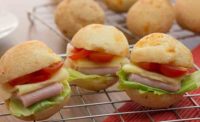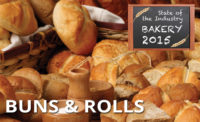While the core market for buns and rolls across retail and foodservice remains steadily anchored in tradition, specialized niches continue to grow, building incremental category interest—and revenue. These specialized products, which can often command a premium price point, include health and wellness, gluten-free, ethnic inspirations, upscale options and sometimes the occasional hybrid. Collectively, this makes for a lively analysis of the buns and rolls market, a category instrumental to our omnipresent American sandwich culture.
Overview | Bread | Tortillas | Sweet Goods | Snack Cakes | Pizza | Desserts | Cookies | Buns & Rolls | Bars | Breakfast Products
Market data
Growth slowed somewhat in the “all other” fresh rolls/buns/croissants segment of fresh bread over the 52 weeks ending March 25, 2018, but still remained on a positive trajectory, up 1.84 percent in dollar sales to $2.2 billion, per IRI, Chicago. Top performance came from King’s Hawaiian, up 7.12 percent to $480.0 million; Campbell Soup Co., which owns the Pepperidge Farm buns and rolls business, up 6.56 percent to $124.4 million; and H&S Bakery, up 7.32 percent to $27.4 million.
The hamburger and hot dog buns segment saw slight improvement over 2017, but was still off 0.54 percent to $1.9 billion. The only notable gain in the segment came from Campbell Soup Co., up 10.87 percent to $101.9 million.
Looking back
Convenience, health and wellness, and premiumization are top trends in buns and rolls today, suggests Ashley Robertson, market manager, breads and rolls, Corbion, Lenexa, KS. “The convenience trend presents significant opportunity for retail bun/roll manufacturers as consumers shift away from consuming three meals a day to enjoying smaller, wholesome, on-the-go meals. As it relates to the health and wellness trend, we’ve seen an increase in nutrient-dense, whole-grain and gluten-free products that give consumers a healthier bun/roll to accommodate their nutritional goals/needs.” She notes that consumers are willing to spend more on higher-quality products that bring new, artisanal or culturally influenced flavors.
Richard Breeswine, president and CEO, Koenig Bakery Systems, Ashland, VA, notes increasing retail market potential for specialty/ethnic items like challah buns or rolls.
Foodservice and retail customers are also requesting more clean-label buns and rolls, along with more artisan-style rolls, notes Norm Ross, technical service representative, Bay State Milling, Mooresville, NC. “Whole grains and ancient grains are growing segments, while organic remains very strong.” He suggests clean-label considerations of note include no artificial flavors, colors or preservatives, and no high-fructose corn syrup.
At the beginning of 2018, Ozery Bakery launched a new Brioche Thin Buns product that’s egg- and dairy-free, made with sunflower oil. The buns are also non-GMO and free from artificial preservatives.
“Due to more active lifestyles, more than 50 percent of meals are being consumed outside of the home,” says Robertson. “This means foodservice operators and manufacturers have a lot of opportunity when it comes to the types of breads and rolls they serve. Over the years, we’ve seen a shift in foodservice menus as they look to go beyond traditional buns and rolls and offer more premium options, including brioche buns, focaccia and pretzel rolls. Many foodservice companies have also added nutrient-dense, gluten-free buns/rolls that are made with quinoa, amaranth and other gluten-free ingredients in an effort to meet growing demands for healthier and/or gluten-sensitive alternatives.”
Sourdough has also been trending forward in both retail and foodservice. In March 2018, Burger King added a new bun to accompany its new Sourdough King menu items, for both burgers and breakfast sandwiches. The bun is a hybrid between traditional sourdough toast and a burger bun.
“Our customers are telling us that they want to reduce yeast and work more with sourdough,” says Breeswine. “We perceive a high trend to ‘back to the roots’ breads.”
Breakfast—often at any hour of the day—continues to drive foodservice revenue. “Breakfast sandwiches are growing at an amazing pace,” says Ross.
“Breakfast seems to be of higher value for consumers as a good preparation for a busy day, whether convenient solutions such as ready-made sandwiches or nutritional, high-protein bread for breakfast at home,” says Breeswine. “Filled sandwiches are very popular, with high-quality ingredients and in unusual combinations and styles. Also filled pretzel rolls are becoming more popular.”
Mintel research has shown that nearly half of consumers are looking for premium burger buns, including pretzel, Kaiser and brioche.
The J&J Snack Foods brand Labriola launched a line of artisan soft pretzel hamburger buns in late 2017, suited to retail in-store bakery or foodservice markets.
Robertson notes foodservice manufacturers and chefs are taking traditional sandwiches to the next level with more innovative and premium sandwich offerings that include fresh artisanal bread products, such as pretzel bread, ciabatta and focaccia.
Gluten-free is still making inroads to chain foodservice. Chick-fil-A made news in June 2017 when it launched a gluten-free bun made with quinoa and amaranth, sweetened with molasses and raisins. The buns are individually wrapped to prevent cross-contamination in the back of the house. Patrons can order the bun with any menu item, but need to assemble the sandwich themselves after ordering, thereby better protecting the operator from potential liability.
Bringing this bun and roll diversity to market requires investment in the right equipment. “High-quality breads are demanded by consumers,” says Breeswine. “This often means soft doughs with high hydration and long dough resting time and little or no baking improvers. Processing soft doughs can be a challenge.” He notes that this approach often requires gentle dough handling, following gravitational principles for tension-free movement of the dough.
“The challenge is also to produce as many different buns as possible on only one line,” says Breeswine. “Koenig supplies multifunctional bun lines for products ranging from small-weight dinner rolls to Kaiser rolls, hamburger buns to sub rolls and up to large-weight baguettes.” He notes the machines facilitate quick changeovers with “basically no downtime.”
Looking forward
At retail, consumers want fresh bread at any time of the day, notes Breeswine. “This is an extreme challenge for bakers, and this is why bakeries often produce half-baked or frozen buns for baking in shops several times a day. Koenig is working together with Swiss manufacturer Cetravac to supply customers with the optimum vacuum cooling technology in form of batch chambers for bakery racks or continuous systems. Vacuum cooling means that half-baked or ready-baked products are stabilized and cooled after baking. Therefore, the volume increases, the shelf-life is prolonged and the following logistics chain is simplified.”
Breeswine notes that the integration of vacuum conditioning can be used both for products that are ready-to-bake at the point of sale, as well as ready-to-eat, frozen goods. “With this developed process, bakers are able to have a juicy crumb and crunchy crust by simply unfreezing at any arbitrary point. By including vacuum cooling technology and the following reduction of water in the baked goods, the baking time can be reduced by approximately 30 percent for half-baked products.”
Quality improvements will always attract attention. “The premiumization and health and wellness trends are what bakers should pay attention to as they develop new products,” says Robertson. She suggests going global for inspiration. “To keep up with these trends in the coming year, bakers will need to be more innovative with flavors from around the globe, as well as incorporating ingredients that are more nutrient-dense. Products made with these unique flavors and healthier ingredients are often perceived as premium by consumers. Bakers can also look at the nostalgic baked goods they offer and find ways to add a unique spin to some of those traditional favorites to better align with consumer demands.”
Breeswine points to the popularity of using spices in buns and rolls, such as turmeric buns, resulting in a product with an interesting yellow color—a product type likely inspired by sfoof, a traditional Lebanese turmeric bun, as well as the overall healthy turmeric trend currently at play.
“We think that bakers need to keep a close eye on the behavior of millennials and upcoming generations,” says Breeswine. “These are the consumers of the present and future, often with high income—but also high demands for quality breads and buns. These consumer groups can change their demands overnight. A bun spread via social media can be trendy within a few hours.”
And keep an eye on organic. “I see organic making big gains,” says Ross. “I’m a big fan of sprouted grains, either particulates or milled to flour. I think the flavor of sprouted grain is amazing. I’d say keep an eye on high-fiber products. The millennial generation expects healthier options with great taste.”
Overview | Bread | Tortillas | Sweet Goods | Snack Cakes | Pizza | Desserts | Cookies | Buns & Rolls | Bars | Breakfast Products








